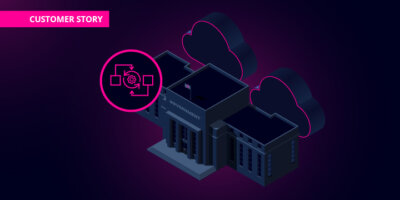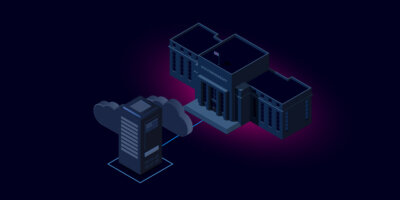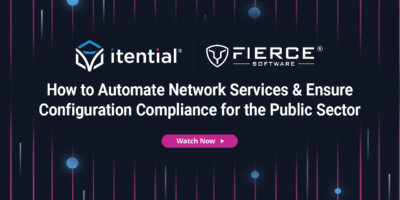Executive Overview
Federal agencies today are under immense pressure to modernize legacy infrastructure while simultaneously meeting the demands of Zero Trust mandates, evolving cybersecurity frameworks, and mission-critical service delivery. The challenge is steep: outdated devices, fragmented tooling, manual workflows, and increasing complexity across hybrid IT and OT environments. All of this must be managed by teams that are often small, under-resourced, and burdened with growing compliance and audit requirements.
At the same time, expectations are rising. Mandates like OMB M-22-09 and EO 14028 call for continuous policy enforcement, secure-by-default operations, and demonstrable alignment with standards such as NIST CSF 2.0 and DISA STIGs. But for most agencies, the path to modernization remains blocked by bottlenecks in the infrastructure itself – manual ticketing processes, siloed automations, and brittle scripts that can’t scale.
This white paper explores how Itential enables federal IT teams to overcome these barriers and operationalize Zero Trust principles through secure, low-code automation and orchestration. Built for hybrid environments and designed to work with the tools agencies already use, Itential helps federal teams:
- Automate complex workflows across networking, security, and infrastructure domains.
- Enforce compliance continuously with audit-ready reporting.
- Integrate existing scripts, platforms, and policies into reusable, governed flows.
- Accelerate mission delivery by turning tickets into self-healing workflows.
Whether the goal is STIG compliance, secure network segmentation, or IT/OT integration, Itential provides the scalable foundation for transforming infrastructure from a liability into a force multiplier.
Itential delivers secure, low-code automation that unifies tools, enforces compliance, and accelerates modernization – giving federal IT leaders a scalable path to operationalize Zero Trust and meet mission demands.
Legacy Infrastructure Meets Modern Mandates
Modernization in the public sector isn’t just a technology upgrade, it’s a mission-critical requirement. Agencies must deliver services faster, operate more securely, and meet rising expectations for resilience, agility, and compliance. But for most infrastructure teams, that mission is slowed or blocked by the reality of their environments.
The following sections provide an in-depth look at each phase and its significance in the broader context of network management.
The Federal Modernization Gap
![]()
Modern mandates demand speed, security, and resilience, but legacy devices, manual changes, and IT/OT silos create barriers that even the most capable federal teams can’t overcome alone.
Outdated Systems, Elevated Risk
Federal procurement cycles and vendor approval processes mean many agencies still rely on infrastructure significantly older than in most enterprise networks. These devices often lack modern APIs, introduce security gaps, and make change execution slow and error prone.
Compliance Without Orchestration Is Unsustainable
OMB M-22-09, EO 14028, NIST CSF 2.0, and DISA STIGs require continuous, auditable compliance. Many teams still rely on manual checks and reactive fixes, making drift inevitable.
Manual Change Processes Drain Resources
Ticket-based workflows and CLI-driven changes lack standardization, rollback control, and central visibility, increasing both time to deliver and operational risk.
IT/OT Fragmentation Creates Blind Spots
Federal networks span IT and OT, yet operate in silos. Security policy enforcement and compliance monitoring often stop at domain boundaries.
Small Teams, High Expectations
A handful of engineers may be responsible for thousands of devices, Zero Trust progress, outage prevention, cloud adoption, and audit readiness – all while managing tool sprawl and legacy systems.
The Orchestration Imperative
The problem for most agencies isn’t a lack of automation – it’s too much of it, trapped in silos. Teams have accumulated scripts, vendor-specific tools, and playbooks that work in isolation but can’t deliver secure, end-to-end workflows.
Orchestration changes that equation. Itential unifies automation across legacy and modern systems, turning fragmented, domain-specific tools into governed, multi-domain workflows that are:
The following sections provide an in-depth look at each phase and its significance in the broader context of network management.
Orchestration: The Mission Multiplier
![]()
Itential unifies fragmented automations into secure, policy-driven workflows that work across legacy and modern systems enabling faster changes, continuous compliance, and reduced strain on federal IT teams.
![]()
Policy-Driven
Every action aligns with STIG, NIST RMF, and Zero Trust requirements.
![]()
Safe by Design
Real-time telemetry gates and rollback prevent outages before they happen.
![]()
Reusable
Existing automations are centralized, version-controlled, and callable from any workflow.
![]()
Auditable
Every change is logged in machine-readable form, mapped to compliance controls.
With this orchestration fabric, agencies can:
- Automate across enclaves without rewriting tools or losing past investments.
- Prove compliance continuously, not just during audits.
- Execute mission-critical changes in minutes instead of days or weeks.
- Reduce operational strain on already constrained teams.
In short, orchestration transforms fragmented automation into a force multiplier – enabling modernization without disrupting the mission.
Why Federal Agencies Choose Itential
Itential is purpose-built for the complexity and mission demands of the federal environment. We provide the orchestration fabric that unites existing automation investments, bridges legacy and modern systems, and enforces policy across every domain, without forcing agencies to rip and replace tools.
Proven across defense, civilian, and intelligence networks, Itential is trusted to:
- Operate in mission-critical environments where downtime is not an option
- Work seamlessly with the infrastructure and automation already in place
- Scale from small enclaves to enterprise-wide, multi-domain orchestration
- Provide full auditability from the first change and resiliency for every change after
With Itential, agencies gain the ability to modernize in place, move faster without creating new risk, and ensure compliance is continuous rather than episodic.
The following sections provide an in-depth look at each phase and its significance in the broader context of network management.

Over time, we’ve been a little slow to adopt new tools, or even devices due to federal regulations. But to scale our network, our capabilities, we need to rapidly change how we’re working to manage configuration compliance with our team and Itential is the platform to get us there.
Senior Network Engineer, U.S. Federal Agency
Secure & Scalable by Design: Core Platform Capabilities
Beneath every orchestrated workflow is a platform built for operational resilience, security, and governance. Itential’s architecture provides the control and visibility federal agencies require to operate at scale – without sacrificing compliance or introducing risk.
The following sections provide an in-depth look at each phase and its significance in the broader context of network management.
Operate at Scale
![]()
These capabilities ensure every orchestrated change is secure, observable, governed, and aligned with mission and compliance requirements, making the platform just as strong as the workflows it powers.
Key platform services include:
SSO & Role-Based Access Control
Integrate with identity providers and enforce granular access permissions for workflow design, execution, and approvals.
Design & Execution RBAC
Ensure only authorized users can create or run automation logic, with separation of duties and policy enforcement built in.
Logging & Audit Trails
Every action (human or machine) is logged and traceable, providing full transparency for audits, investigations, and reporting.
Event Triggering
Trigger events across systems and workflows, enabling responsive automation and real-time change correlation.
Secrets Management
Securely store and manage credentials, tokens, and keys used in orchestrated actions – without exposing sensitive data in plain text.
Archive & Replay
Persist and recall historical executions to support root-cause analysis, rollback planning, and forensic investigations.
Insights
Visualize automation performance, track outcomes, and identify opportunities to optimize execution across domains.
How Itential Helps Federal Agencies
Itential enables federal agencies to modernize infrastructure operations with confidence by orchestrating the critical workflows that support Zero Trust, enforce compliance, and accelerate mission delivery across complex, hybrid environments.
![]()
Zero Trust Enforcement
Apply micro-segmentation, policy controls, and continuous configuration checks across all network domains.
![]()
Mission-Ready Change Management
Replace multi-day ticket queues with pre-approved, policy-gated workflows.
![]()
Hybrid IT/OT Operations
Orchestrate network, cloud, and OT systems from a single control plane.
![]()
STIG Compliance at Scale
Automatically capture running configs, enforce baselines, and remediate drift.
How Itential Helps Federal Partners
Prime contractors, systems integrators, and solution providers trust Itential to:
- Extend orchestration into customer environments without replacing existing tools.
- Standardize service delivery across classified, coalition, and unclassified networks.
- Reduce operational risk with governed, auditable workflows.
- Accelerate program timelines by automating onboarding, provisioning, and compliance reporting.
Customer Success Story
A U.S. federal agency operating mission-critical national infrastructure faced growing challenges managing change at scale. Decentralized tools, manual tasks, and brittle scripts slowed the agency’s ability to respond to evolving missions and maintain continuous compliance. At the same time, auditors were increasing pressure to enforce STIG policies and produce verifiable change records across a sprawling hybrid network.
The agency selected Itential to implement a secure, policy-governed orchestration layer. Their approach prioritized high-impact workflows that would improve security posture and operational efficiency without disrupting core services. Early automation efforts focused on:
- Enforcing configuration baselines across thousands of devices.
- Validating and remediating interface compliance.
- Integrating with their ITSM platform to enable governed, auditable workflows.
Real-World Impact
![]()
With Itential, a U.S. federal agency cut change execution from days to minutes, moved STIG compliance to real-time enforcement, and eliminated manual scripts – all without disrupting mission-critical operations.
The Outcome
Repeatable workflows replaced manual scripts, policy checks became continuous rather than reactive, and STIG compliance efforts moved from point-in-time reviews to real-time enforcement. Changes that once sat in ticket queues for days now execute within minutes, with full rollback and logging in place, giving the agency speed without compromising control.
Conclusion
Federal missions cannot afford infrastructure that is slow to change, difficult to secure, or impossible to audit. Itential gives agencies and partners the orchestration fabric needed to modernize in place, enforce policy continuously, and operate at mission speed – without disrupting operations.


